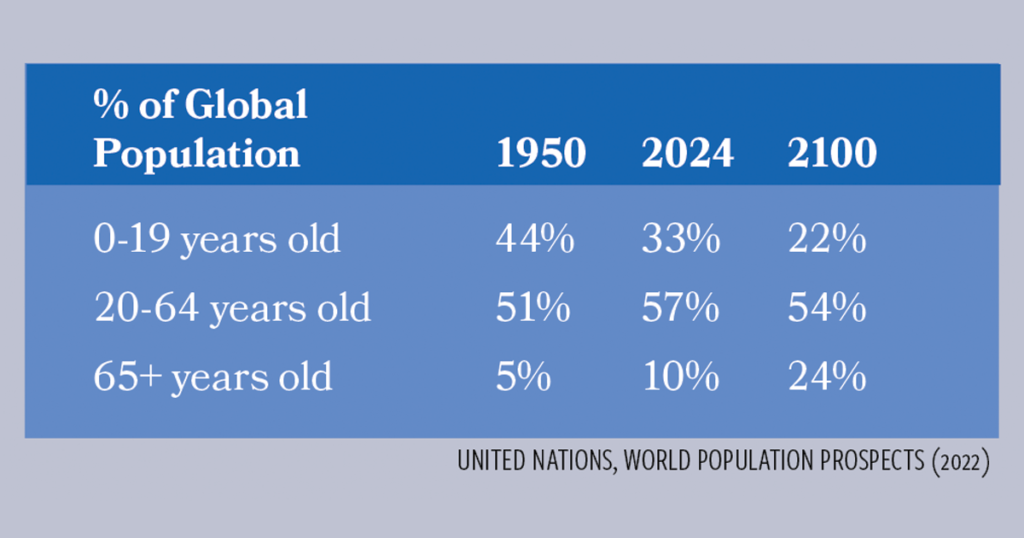Wisdom Shaping the Future
"To effectively prepare for today and tomorrow, we need officers and soldiers who diligently seek to understand what God is doing in the world."
God’s divine plan encompasses the past, present, and future. Throughout history, God has revealed glimpses of the future to His followers. Consider Joseph, who interpreted Pharaoh’s dreams to identify fourteen years of plenty and famine. That insight enabled him to enact a strategy which resulted in the preservation of Egypt and Israel.
The ability to discern the future is not limited to prophets alone. There are several clues that reveal God’s plan for the world. I refer to these global forces that will shape the future as megatrends. By understanding how megatrends will impact the world in 25, 50, and even 100 years, we gain valuable insight into where we should invest our attention and resources to maximize Kingdom impact.
Megatrend 1: By the end of the century, the world’s population will begin to decline.
We have witnessed remarkable population growth over the past 75 years, with the number of global citizens tripling from 2.5 billion to 8.0 billion today. The United Nations projects the global population will peak in 2086 at 10.4 billion, marking a 30% increase from today. And then, for the first time since the great flood, the world’s population will begin to decline. A shrinking population will present unprecedented challenges for future generations. By the end of the century, only Africa will have a significantly growing population.
In order for a society to maintain its population size, its fertility rate must be 2.1 live births per woman or higher (exclusive of the impact of migration). Today, the fertility rate is at or below that critical level in Europe (1.5), North America (1.6), South America (1.8), Asia (1.9), and Oceania (2.1).
In contrast, Africa boasts a fertility rate of 4.1 today. The UN expects Africa’s population will surge from 1.5 billion to 3.9 billion by 2100, ultimately representing 40% of the world’s population. One hundred years from now, Africa will surpass Asia as the most populous continent, a status it will likely maintain for centuries.
The burgeoning African population will result in greater significant economic, political, and social influence globally.
With these trends in mind, how will The Salvation Army meet the needs of:
- Generation Alpha and the generations that follow who will require skills and resources needed to tackle the unprecedented challenges of global population decline?
- The people of Africa who must be poised for significant growth?
- Officers and soldiers who will need to adeptly serve a diverse culture that reflects multinational influences in economic, political, and social spheres?
Megatrend 2: The world’s age structure will shift, resulting in more seniors than youth.
Declining fertility rates coupled with increasing life expectancy will reshape the age structure of the global population.
The proportion of individuals aged 65 and above is projected to soar from 5% in 1950 to 24% by 2100. While some countries, including the United States, have recognized this trend, the world remains unprepared for the realities of an aging population.

Conversely, the percentage of youth globally will decline from 33% today to 22% by the end of the century. To put this in perspective, in 1950 there were nine children for every senior. Today, there are three children for every senior. By 2100, the number of seniors is expected to surpass that of children, signaling a dramatic demographic shift.
How will The Salvation Army meet the needs of:
- A growing senior population which will require unique social, medical, and spiritual services?
- The Salvation Army itself which should find ways to leverage the wisdom and experiences of seniors and effectively engage them to serve the Kingdom?
- Working adults who will face growing pressure to care for their senior family members?
Megatrend 3: Artificial intelligence (AI) will fuel the growth of the Gig Economy.
My daughter, a freshman in college, shared that Gen Z is actively seeking careers that cannot be replaced by artificial intelligence. That is wise.
Over the next few decades, AI will radically change the nature of work. While this surely comes as no surprise, most people are unaware of the magnitude of change that is coming.
Forecasts indicate that by 2030, AI could automate up to 30% of tasks currently performed within the US economy. As a result, McKinsey expects 12 million job transitions will be required by the end of this decade. These displaced workers will require job retraining and support while they look for opportunities that meet their needs.
Most predictions of AI’s impact on labor focus on computers replacing humans in accomplishing tasks such as driving, copywriting, or preparing taxes. However, a more profound transformation is on the horizon.
Over the next decade, AI systems will be able to parcel and assign work to people and computers in order to accomplish objectives efficiently. This will result in increasing specialization. As AI systems learn which tasks a person excels in, they will assign more of the right tasks to the right person.
AI-driven workforce management will accelerate a key labor trend that has already begun: the growth of the Gig Economy. This term refers to people who take up freelance work as a substitute for or in addition to full-time employment. The World Bank reported rapid growth in the Gig Economy over the past few years, now representing 12 percent of the global labor market. Gig work is especially attractive to young people and women looking to earn extra income, learn new skills, and have the flexibility to combine work with other responsibilities. In the United States, McKinsey & Company reported the growth of the Gig Economy is even more substantial, increasing from 27 percent in 2016 before the COVID pandemic to 36 percent in 2022.
The combination of AI-driven task delegation and workers seeking greater autonomy will result in increasing job specialization and will redefine traditional employer-employee dynamics. Workers will gravitate towards projects that align with their interests and expertise rather than pursuing an ideal employer.
In order to succeed in this new era, organizations will need to understand how best to engage freelancers to advance their missions.
In light of the upcoming realities facing the global labor market, how will The Salvation Army meet the needs of:
- Displaced workers who will require job retraining and support during periods of unemployment?
- A freelance workforce which can help advance the ministry’s impact by accomplishing specialized tasks?
- Candidates and local leaders who will choose to join the ministry because of a passion for its mission and a culture that allows them to flourish?
As a truly global ministry, The Salvation Army can play a critical role in addressing the adverse effects of population decline, a changing age structure, and AI-driven transformation of the labor market. To effectively prepare for today and tomorrow, we need officers and soldiers who diligently seek to understand what God is doing in the world. In addition to devoted prayer and keen observation, this requires researching the latest trends, learning from experts in various industries, and engaging in various learning and development opportunities.
God has a plan for the future of the world. And The Salvation Army is uniquely positioned to have tremendous Kingdom impact over the coming years and decades.
For book suggestions on wisdom, check out The National Commander’s Bookshelf. | Illustration by Janie Hao







